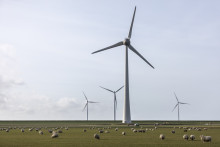Two years ago, Dhallé's research group received a subsidy of two million euros in the context of the EcoSwing project for the development of a power generator with superconducting coils. The resulting machine is 40% lighter than traditional generators with their heavy magnets and copper coils.
'Because of the lower weight, the nacelle of a windmill can be much lighter and we need less material for the mast. Thanks to this, the cost of a windmill will markedly decrease in the future,' says the Belgian scientist, who works at the UT as a senior lecturer of Energy, Materials and Systems (EMS).
Early next year, the first superconducting generator will be built in an existing windmill in Thyborøn in Denmark, owned by the Chinese turbine builder Envision. Once the generator has run error-free for one year, there will be basis for commercial mass production of cheaper windmills.

Envision has consciously chosen a comparatively modest 3.6 megawatts generator, as this is currently the most common capacity in the wind industry. Moreover, this size just fits on a lorry, which makes a huge difference in transportation costs. 'The entire design, however, aims for a capacity of more than 10 megawatts,' says Dhallé. 'That is enough to provide power for three thousand households.'
Yttrium
A traditional wind turbine works just like a bicycle dynamo, Dhallé explains. 'It contains rotating magnets inside a set of copper coils. The rotation creates a variable magnetic field in the coils, and this generates an electric current.' In the newly developed wind generator, the magnets have been replaced by coils with a ceramic compound of yttrium. This silver-white metal becomes superconductive under extremely cold conditions. The resistance of the material is then completely eliminated. Without friction loss, a hundred times more power flows through the ceramic coils than through copper coils.
Many metals only become superconductive at temperatures below minus 270°C. However, from a discovery in the 1980’s we know that some ceramics become superconductive at higher temperatures. For yttrium this is at minus 180°C. 'That makes a huge difference in cooling costs.'
To generate the required low temperature, the researchers place their generator in a super-refrigerator. This is suspended in a vacuum drum in the heart of the generator in the nacelle of the windmill. This generator weighs about 45 tonnes, which is light compared to the current generators, which weigh about 75 tonnes.

Rare earth element
Dhallé tells us that yttrium is a rare earth element. 'But you only need one hundred grams to create a superconductive coil. A traditional magnet requires a hundred times more of the material neodymium. In our coil, we use a steel ribbon to which a two-micrometre thin layer of yttrium is applied, which reacts with barium, copper and oxygen. The rotor of our windmill is fitted with forty superconducting coils. In total, the rotor will contain twenty kilometres of this ribbon.'
No less than twelve researchers and students were involved in the design and testing of the coils and the cooling at the EMS department of the University of Twente. They will also assemble the entire rotor. 'It has been an aggressive timeline. In one and a half year, we had to develop the entire concept of combining the various technologies. So far, everything works, but the reasons why it works will have to be the subject of academic research, afterwards,' says the researcher. 'For us, as academics, this approach is new; we are taking a very pragmatic approach in this project. Sometimes we need to solve problems with steam and boiling water. But this also results in new insights. For example, we gradually found out that the new ceramic superconductors are, in their thermal properties, far more stable than earlier superconducting magnets. But they are harder to protect when something goes wrong with the cooling.'
Saving weight
The approach used by the Twente researchers is also very conservative, Dhallé says. 'The design must work smoothly at the first attempt. For that reason, we try to keep all risks as small as possible. Once the windmill is up and running, I am positive that we will be able to save a lot of weight in the next design. Also, the superconductive ribbon for the coils is now three to four times more expensive than copper. This is mainly due to production costs, though; the materials are not expensive. The cable price will drop quickly once mass production has started. Currently, the construction of a traditional windmill costs 2 euros per generated watt. This will become much lower.'

So far, a third of the forty coils have been successfully tested in the Twente lab. This summer, the drum for the rotor coils will be built. The two-blade windmill should be up and running in 2018. In the context of the European Horizon 2020 programme, nine companies and research institutes received 13 million euros in subsidy for this EcoSwing project. Sumitomo in England provides the 'refrigerator' and Theva in Germany builds the coils.







